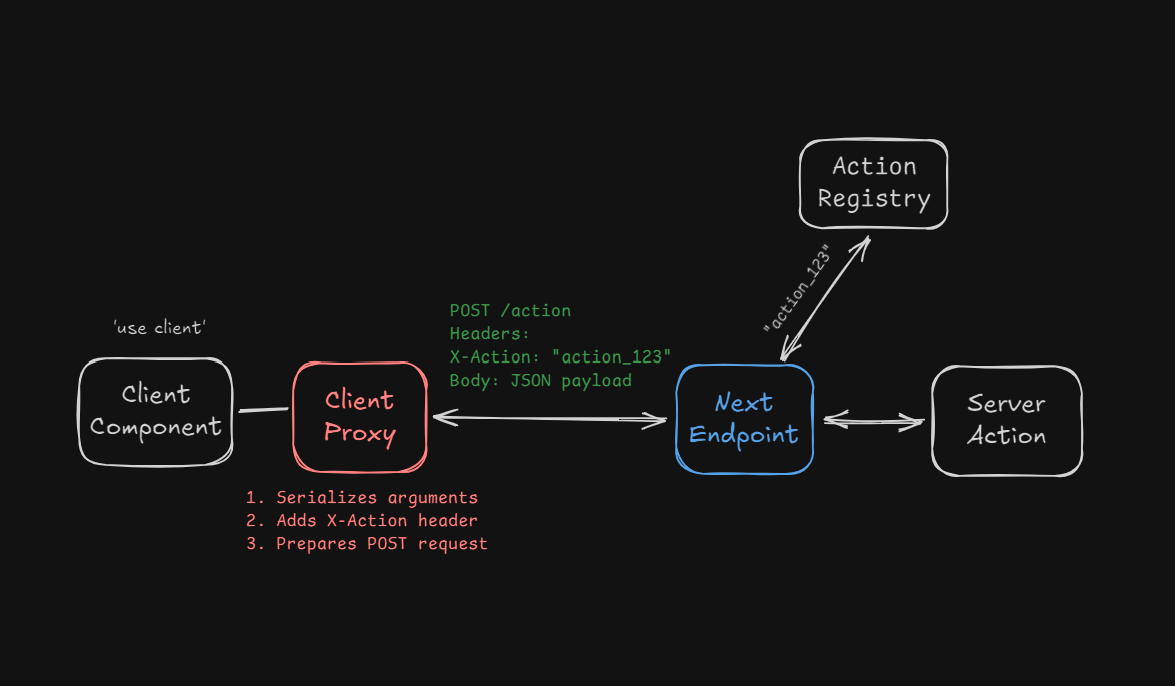What is a Server Action?
A Server Action is an asynchronous function executed on the server, designed for handling data mutations (e.g., form submissions, API calls) directly from React components, serve as a built-in remote procedure call (RPC) mechanism. It eliminates the need for separate API routes, enabling seamless integration of server-side logic with client-side interactions.
Key features:
- Progressive Enhancement: Works even if JavaScript is disabled.
- Caching & Revalidation: Integrates with Next.js caching (e.g.,
revalidatePath,revalidateTag). - Security: Uses encrypted IDs and CSRF protection by default.
How to Create a Server Action
One of the steps to create a server action is to create a file with 'use server'. This tells Next.js to treat the file as a server action.
Copied!// app/actions.ts 'use server'; export async function deletePost(postId: string) { // Delete post from database await db.post.delete({ where: { id: postId } }); revalidatePath('/posts'); // Update cache }
You can then import and use it in your React client components.
Copied!'use client'; import { deletePost } from '@/app/actions'; export function DeleteButton({ postId }: { postId: string }) { return <button onClick={() => deletePost(postId)}>Delete</button>; }
The Core Principle: Remote Procedure Calls (RPC)

At their core, Server Actions implement an RPC pattern using HTTP POST requests. When you write:
Copied!"use server"; export async function createPost(data: FormData) { // Database interaction }
Next.js performs these critical operations:
- Server-Side Registration: During the build process, Next.js scans for functions marked with
"use server". Each such function is registered in an internal “action registry” with a unique action ID. - Client-side proxy generation: Instead of sending the entire function code to the client, Next.js generates a lightweight client proxy. This proxy is merely a thin layer that, when called, packages the function’s arguments (after serialization) and triggers a
POSTrequest. - Security wrapping: Adds automatic CSRF protection for requests.
And finally, when the server action is invoked from the client like this:
Copied!<form action={createPost}> <input name="content" /> <button>Submit</button> </form>
When the client invokes the proxy (e.g., from a button click or a form submission), the browser submits a POST request with the action ID and serialized headers, the whole process is as follows:
1. Serialization of function's arguments:
- FormData is encoded using
multipart/form-data - Non-form invocations use JSON.stringify() with SuperJSON for rich type support
2. Request Dispatch: The proxy sends a POST request to a hidden endpoint with the action ID and serialized parameters.
Copied!POST /createPost HTTP/1.1 Content-Type: multipart/form-data X-Action: "ACTION_ID" X-Forwarded-Host: example.com ...
3. Server Processing: The server intercepts the request, and:
- Next.js runtime matches the
X-Actionheader to registered functions. - Deserializes payload using inverse of client-side encoding.
- Executes within isolated server context (no client dependencies).
4. Response Handling:
- The output is serialized and returned to the client.
- The client proxy receives the response and continues execution as if it were a direct function call.
This remote procedure call (RPC) pattern means that—despite the illusion of a direct function call—every server action is performing a network round-trip over HTTP behind the scenes. The beauty of this abstraction is that it eliminates the need to manually create and maintain separate API endpoints for many common operations.
Security Architecture
Server Actions implement enterprise-grade security by default:
CSRF Protection
- Automatic CSRF tokens: Each server action request includes a unique CSRF token in the headers.
- Signed double-submit cookies with
__Host-prefix - Strict origin matching via
Sec-Fetch-Siteheader validation
Payload Validation
- Type safety: TypeScript types are enforced on the server side.
Copied!// Next.js generates runtime validation from TypeScript types: if (typeof data.content !== "string") { throw new ActionError("Invalid payload"); }
No runtime type safety
Always validate server action inputs with Zod, as TypeScript types alone don’t provide runtime safety.
Isolation Boundaries
- Server-side isolation: Server actions run in a separate Node.js process, isolated from the client runtime.
- Timeouts enforced via
AsyncLocalStorage.
Conclusion
Server Actions represent a fundamental shift in web architecture, enabling developers to build full-stack applications with minimal boilerplate. By abstracting away the complexities of network communication and security.